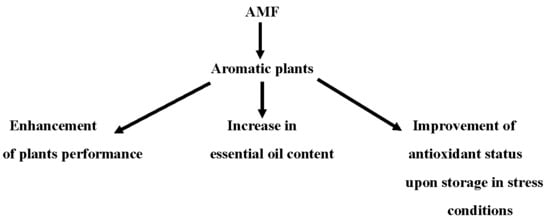Yield, Essential Oil and Quality Performances of Artemisia dracunculus, Hyssopus officinalis and Lavandula angustifolia as Affected by Arbuscular Mycorrhizal Fungi under Organic Management
Abstract
:1. Introduction
2. Results and Discussion
2.1. AMF Effect on Plant Growth, Development and Root Mycorrhizal Colonization, Essential Oil Content, Antioxidant Activity and Phenolics Content
2.2. Effect of Abiotic Stress
2.3. Elemental Composition
3. Material and Methods
3.1. Growth Conditions and Experimental Protocol
3.2. Sample Preparation
3.3. Dry Residue
3.4. Ascorbic Acid
3.5. Polyphenols
3.6. Antioxidant Activity (AOA)
3.7. Photosynthetic Pigments
3.8. Essential Oil Extraction and Analysis
3.9. Total Dissolved Solids (TDS)
3.10. Elemental Composition
3.11. Statistical Analysis
4. Conclusions
Supplementary Materials
Author Contributions
Funding
Conflicts of Interest
References
- Malik, A.A.; Suryapani, S.; Ahmad, J. Chemical Vs Organic Cultivation of Medicinal and Aromatic Plants: The choice is clear. Int. J. Med. Arom. Plants 2011, 1, 5–13. [Google Scholar]
- Basu, S.; Rabara, R.C.; Negi, S. AMF: The future prospect for sustainable agriculture. Physiol. Mol. Plant Pathol. 2018, 102, 36–45. [Google Scholar] [CrossRef]
- Begum, N.; Qin, C.; Ahanger, M.A.; Raza, S.; Khan, M.I.; Ashraf, M.; Ahmed, N.; Zhang, L. Role of Arbuscular Mycorrhizal Fungi in Plant Growth Regulation: Implications in Abiotic Stress Tolerance. Front. Plant Sci. 2019, 10, 1068. [Google Scholar] [CrossRef] [PubMed] [Green Version]
- Kim, S.J.; Eo, J.-K.; Lee, E.-H.; Park, H.; Eom, A.-H. Effects of Arbuscular Mycorrhizal Fungi and Soil Conditions on Crop Plant Growth. Mycobiology 2017, 45, 20–24. [Google Scholar] [CrossRef] [PubMed] [Green Version]
- Chen, S.; Zhao, H.; Zou, C.; Li, Y.; Chen, Y.; Wang, Z.; Jiang, Y.; Liu, A.; Zhao, P.; Wang, M. Combined inoculation with multiple arbuscular mycorrhizal fungi improves growth, nutrient uptake and photosynthesis in cucumber seedlings. Front. Microbiol. 2017, 8, 2516. [Google Scholar] [CrossRef] [PubMed]
- Amiri, R.; Nikbakht, A.; Etemadi, N. Alleviation of drought stress on rose geranium Pelargonium graveolen L Herit. In terms of antioxidant activity and secondary metabolites by mycorrhizal inoculation. Sci. Hort. 2015, 197, 373–380. [Google Scholar] [CrossRef]
- Tarraf, W.; Ruta, C.; De Cillis, F.; Tagarelli, A.; Tedone, L.; De Mastro, G. Effects of mycorrhiza on growth and essential oil production in selected aromatic plants. Ital. J. Agron. 2015, 10, 160–162. [Google Scholar] [CrossRef]
- Rasouli-Sadaghiani, M.H.; Hassani, A.; Barin, M.; Danesh, Y.R.; Sefidkon, F. Effects of arbuscular mycorrhizal (AM) fungi on growth, essential oil production and nutrients uptake in basil. J. Med. Plants Res. 2010, 4, 2222–2228. [Google Scholar] [CrossRef]
- Khaosaad, T.; Vierheilig, H.; Zitterl-Eglseer, K.; Novak, J. Arbuscular mycorrhiza alters the concentration of essential oils in oregano (Origanum sp., Lamiaceae). Mycorrhiza 2006, 16, 443–446. [Google Scholar] [CrossRef]
- Kapoor, R.; Chaudhary, V.; Bhatnagar, A.K. Effects of arbuscular mycorrhiza and phosphorus application on artemisinin concentration in Artemisia annua L. Mycorrhiza 2007, 17, 581–587. [Google Scholar] [CrossRef]
- Gupta, M.L.; Prasad, A.; Ram, M.; Kumar, S. Effect of the vesicular–arbuscular mycorrhizal (VAM) fungus Glomus fasciculatum on the essential oil yield related characters and nutrient acquisition in the crops of different cultivars of menthol mint (Mentha arvensis) under field conditions. Bioresour. Technol. 2002, 81, 77–79. [Google Scholar] [CrossRef]
- Copetta, A.; Lingua, G.; Berta, G. Effects of three AM fungi on growth, distribution of glandular hairs, and essential oil production in Ocimum basilicum L. var. Genovese. Mycorrhiza 2006, 16, 485–494. [Google Scholar] [CrossRef] [PubMed]
- Kapoor, R.; Giri, B.; Mukerji, K.G. Improved growth and essential oil yield and quality in Foeniculum vulgare Mill. on mycorrhizal inoculation supplemented with P-fertilizer. Bioresour. Technol. 2004, 93, 307–311. [Google Scholar] [CrossRef] [PubMed]
- Ponce, M.A.; Scervino, J.M.; Erra-Balsells, R.; Ocampo, J.A.; Godeas, A.M. Flavonoids from shoots and roots of Trifolium repens (white clover) grown in presence or absence of the arbuscular mycorrhizal fungus Glomus intraradices. Phytochemistry 2004, 65, 1925–1930. [Google Scholar] [CrossRef]
- Karagiannidis, N.; Thomidis, T.; Lazari, D.; Panou-Filotheou, E.; Karagiannidou, C. Effect of three Greek arbuscular mycorrhizal fungi in improving the growth, nutrient concentration, and product ion of essential oils of oregano and mint plants. Sci. Hort. 2011, 129, 329–334. [Google Scholar] [CrossRef]
- Karagiannidis, N.; Thomidis, T.; Panou-Filotheou, E. Effects of Glomus lamellosum on growth, essential oil production and nutrients uptake in selected medicinal plants. J. Agric. Sci. 2012, 4, 137–144. [Google Scholar] [CrossRef] [Green Version]
- Koch, A.M.; CrollR, D.P.; Sanders, I.R. Genetic variability in a population of arbuscular mycorrhizal fungi causes variation in plant growth. Ecol. Let. 2006, 9, 103–110. [Google Scholar] [CrossRef] [Green Version]
- Golubkina, N.A.; Amagova, Z.A.; Matsadze, V.; Zamana, S.P.; Tallarita, A.; Caruso, G. Effects of arbuscular mycorrhizal fungi on yield, biochemical characteristics and elemental composition of garlic and onion under selenium supply. Plants 2020, 9, 84. [Google Scholar] [CrossRef] [Green Version]
- Kekina, H.; Shevchuk, O.; Golubkina, N.; Logvinenko, L.; Khlipenko, L.; Molchanova, A.; Caruso, G. Antioxidant properties and elemental composition of Withania somnifera L. Agric. Food 2019, 7, 93–103. [Google Scholar]
- Colombo, R.P.; Martínez, A.E.; Fernández di Pardo, A.; Bidondo, L.F.; van Baren, C.; di Leo Lira, P.; Godeas, A.M. Differential effects of two strains of Rhizophagus intraradices on dry biomass and essential oil yield and composition in Calamintha nepeta. Rev. Argent Microbiol. 2013, 45, 114–118. [Google Scholar] [CrossRef] [Green Version]
- Rydlová, J.; Jelínková, M.; Dušek, K.; Dušková, E.; Vosátka, M.; Püschel, D. Arbuscular mycorrhiza differentially affects synthesis of essential oils in coriander and dill. Mycorrhiza 2015. [Google Scholar] [CrossRef]
- Zeng, Y.; Guo, L.P.; Chen, B.D.; Hao, Z.P.; Wang, J.Y.; Huang, L.Q.; Yang, G.; Cui, X.M.; Yang, L.; Wu, Z.X.; et al. Arbuscular mycorrhizal symbiosis and active ingredients of medicinal plants: Current research status and perspectives. Mycorrhiza 2013, 23, 253–265. [Google Scholar] [CrossRef] [PubMed]
- Raghuwanshi, R.; Sinha, S. Linking Mycorrhizal Technology with Medicinal Plant Secondary Metabolites, Microbial Diversity and Biotechnology in Food Security. In Microbial Diversity and Biotechnology in Food Security; Kharwar, R.N., Upadhyay, R.S., Dubey, N.K., Raghuwanshi, R., Eds.; Springer: New Delhi, India, 2014; pp. 121–132. [Google Scholar]
- Pedone-Bonfim, M.V.L.; Barbosa da Silva, F.S.; Costa, L.M. Production of secondary metabolites by mycorrhizal plants with medicinal or nutritional potential. Acta Physiol. Plant 2015, 37, 27. [Google Scholar] [CrossRef]
- Zhang, H.; Sun, J.Q.; Bao, Y.Y. Advances in studies on plant secondary metabolites influenced by arbuscular mycorrhizal fungi. J. Agr. Biotechnol. 2015, 23, 1093–1103. [Google Scholar]
- Golubkina, N.A.; Zamana, S.; Seredin, T.; Poluboyarinov, P.; Sokolov, S.; Baranova, H.; Krivenkov, L.; Pietrantonio, L.; Caruso, G. Effect of selenium biofortification and arbuscular mycorrhizal fungi on yield, quality and antioxidant properties if shallot bulbs. Plants 2019, 8, 102. [Google Scholar] [CrossRef] [Green Version]
- Sellitto, V.M.; Golubkina, N.A.; Pietrantonio, L.; Cozzolino, E.; Cuciniello, A.; Cenvinzo, V.; Florin, I.; Caruso, G. Tomato yield, quality, mineral composition and antioxidants as affected by beneficial microorganisms under soil salinity induced by balanced nutrient solutions. Agriculture 2019, 9, 110. [Google Scholar] [CrossRef] [Green Version]
- Freitas, M.S.; Martins, M.A.; Vieira, I.J.C. Yield and quality of essential oils of Mentha arvensis in response to inoculation with arbuscular mycorrhizal fungi. Pesq. Agropec. Bras. 2004, 39, 887–894. [Google Scholar] [CrossRef] [Green Version]
- Carlsen, S.C.K.; Understrup, A.; Fomsgaard, I.S.; Mortensen, A.G.; Ravnskov, S. Flavonoids in roots of white clover: Interactions of arbuscular mycorrhizal fungi and a pathogenic fungus. Plant Soil 2008, 302, 33–43. [Google Scholar] [CrossRef]
- Huang, J.H.; Tan, J.F.; Jie, H.K.; Zeng, R.S. Effects of inoculating arbuscular mycorrhizal fungi on Artemisia annua growth and its officinal components. Ying Yong Sheng Tai Xue Bao 2011, 22, 1443–1449. [Google Scholar]
- Jugran, A.; Bahukhandi, A.; Dhyani, P.; Bhatt, I.D.; Rawal, R.; Nandi, S.; Palni, L.M.S. The effect of inoculation with mycorrhiza: AM on growth, phenolics, tannins, phenolic composition and antioxidant activity in Valeriana jatamansi Jones. J. Soil Sci. Plant Nutr. 2015, 15, 1036–1049. [Google Scholar] [CrossRef]
- Hazzoumi, Z.; Moustakime, Y.; Elharchli, E.; Joute, K.A. Effect of arbuscular mycorrhizal fungi (AMF) and water stress on growth, phenolic compounds, glandular hairs, and yield of essential oil in basil (Ocimum gratissimum L). Chem. Biol. Technol. Agr. 2015, 2, 10. [Google Scholar] [CrossRef] [Green Version]
- Rodriguez, R.J.; Henson, J.; Van Volkenburgh, E.; Hoy, M.; Wright, L.; Beckwith, F. Stress tolerance in plants via habitat-adapted symbiosis. Int. Soc. Microb. Ecol. 2008, 2, 404–416. [Google Scholar] [CrossRef] [PubMed] [Green Version]
- Ahanger, M.A.; Tyagi, S.R.; Wani, M.R.; Ahmad, P. Drought tolerance: Role of organic osmolytes, growth regulators, and mineral nutrients. In Physiological Mechanisms and Adaptation Strategies in Plants under Changing Environment; Ahmad, P., Wani, M.R., Eds.; Springer: New York, NY, USA, 2014; Volume 1, pp. 25–55. [Google Scholar] [CrossRef]
- Salam, E.A.; Alatar, A.; El-Sheikh, M.A. Inoculation with arbuscular mycorrhizal fungi alleviates harmful effects of drought stress on damask rose. Saudi J. Biol. Sci. 2017, 25, 1772–1780. [Google Scholar] [CrossRef] [PubMed]
- Hashem, A.; Abd_Allah, E.F.; Alqarawi, A.A.; Egamberdieva, D. Arbuscular mycorrhizal fungi and plant stress tolerance. In Plant Microbiome: Stress Response, Microorganisms for Sustainability; Egamberdieva, D., Ahmad, P., Eds.; Springer Nature Singapore Pte Ltd.: Singapore, 2018; Volume 5. [Google Scholar] [CrossRef]
- D’Souza, R.W.; Lobo, V. Effect of temperature and storage duration on antioxidant status in Coriandrum sativum Linn. Int. J. Life. Sci. Scienti. Res. 2017, 3, 1055–1058. [Google Scholar] [CrossRef]
- Toscano, S.; Trivellini, A.; Cocetta, G.; Bulgari, R.; Francini, A.; Romano, D.; Ferrante, A. Effect of Preharvest Abiotic Stresses on the Accumulation of Bioactive Compounds in Horticultural Produce. Front. Plant Sci. 2019. [Google Scholar] [CrossRef]
- Sharma, A.; Shahzad, B.; Rehman, A.; Bhardwaj, R.; Landi, M.; Zheng, B. Response of Phenylpropanoid Pathway and the Role of Polyphenols in Plants under Abiotic Stress. Molecules 2019, 24, 2452. [Google Scholar] [CrossRef] [Green Version]
- Biswas, S.; Koul, M.; Bhatnagar, A.K. Effect of Salt, Drought and Metal Stress on Essential Oil Yield and Quality in Plants. NPC 2011, 6, 1559–1564. [Google Scholar] [CrossRef] [Green Version]
- Ferrol, N.; Tamayo, E.; Vargas, P. The heavy metal paradox in arbuscular mycorrhizas: From mechanism to biotechnological applications. J. Exp. Bot. 2016, 67, 6253–6265. [Google Scholar] [CrossRef] [Green Version]
- Smith, S.E.; Read, D.J. Mycorrhizal Symbiosis; Academic Press: San Diego, CA, USA, 1997; p. 607. [Google Scholar]
- Muszýnska, E.; Labudda, M. Dual Role of Metallic Trace Elements in Stress Biology—From Negative to Beneficial Impact on Plants Review. Int. J. Mol. Sci. 2019, 20, 3117. [Google Scholar] [CrossRef] [Green Version]
- Sedláček, M.; Pavloušek, P.; Lošák, T.; Zatloukalová, A.; Filipčĭk, R.; Hlušek, J.; Vĭtězová, M. The effect of arbuscular mycorrhizal fungi on the content of macro and microelements in grapevine (Vitis vinifera, L.) leaves. Acta Univ. Agric. Silvic. Mendel. Brun. 2013, LXI, 187–191. [Google Scholar]
- Giovannetti, M.; Mosse, B. An evaluation of techniques for measuring vesicular-arbuscular mycorrhiza in roots. New Phytol. 1980, 84, 489–500. [Google Scholar] [CrossRef]
- Isikov, V.P.; Rabotyagov, V.D.; Khlipenko, L.A.; Logvinenko, I.E.; Logvinenko, K.A.; Kutko, S.P.; Bakova, N.N.; Marko, N.V. Introduction and selection of aromatic and medicinal plants. Methodological and Methodical Aspects; NBG: Yalta, Russia, 2009; 110p. [Google Scholar]
- AOAC. The Official Methods of Analysis of the Association of Official Analytical Chemists International; 22 Vitamin C; AOAC: Washington, WA, USA, 2012. [Google Scholar]
- Golubkina, N.A.; Kosheleva, O.V.; Krivenkov, L.V.; Nadezhkin, S.M.; Dobrutakaya, H.G.; Caruso, G. Intersexual differences in plant growth, yield, mineral composition and antioxidants of spinach (Spinacia oleracea L.) as affected by selenium form. Sci. Hortic. 2017, 225, 350–358. [Google Scholar] [CrossRef]
- Golubkina, N.A.; Kekina, H.G.; Molchanova, A.V.; Antoshkina, M.S.; Nadezhkin, S.M.; Soldatenko, A.V. Plants Antioxidants and Methods of their Determination; FSCVP: Moscow, Russia, 2018. [Google Scholar]
- Kasote, D.M.; Jayaprakasha, G.K.; Patil, B.S. Leaf Disc Assays for Rapid Measurement of Antioxidant Activity. Sci. Rep. 2019, 9, 1884. [Google Scholar] [CrossRef] [PubMed]
- Lichtenthaler, H.K. Chlorophylls and carotenoids: Pigments of photosynthetic biomembranes. Methods Enzymol. 1987, 148, 350–382. [Google Scholar]
- Council of Europe. European Pharmacopoeia, Ph. Eur. 6.0., 6th ed.; Council of Europe: Strasbourg, France, 2007. [Google Scholar]
- Omidbaigi, R.; Hassani, A.; Sefidkon, F. Essential oil content and composition of sweet basil (Ocimum basilicum) at different irrigation regimes. J. Essent. Oil Bear. Plants 2003, 6, 104–110. [Google Scholar] [CrossRef]
- Skalny, A.V.; Lakarova, H.V.; Kuznetsov, V.V.; Skalnaya, M.G. Analytical Methods Bioelementology. St. Petersburg Sci. 2009, 38–45. [Google Scholar]
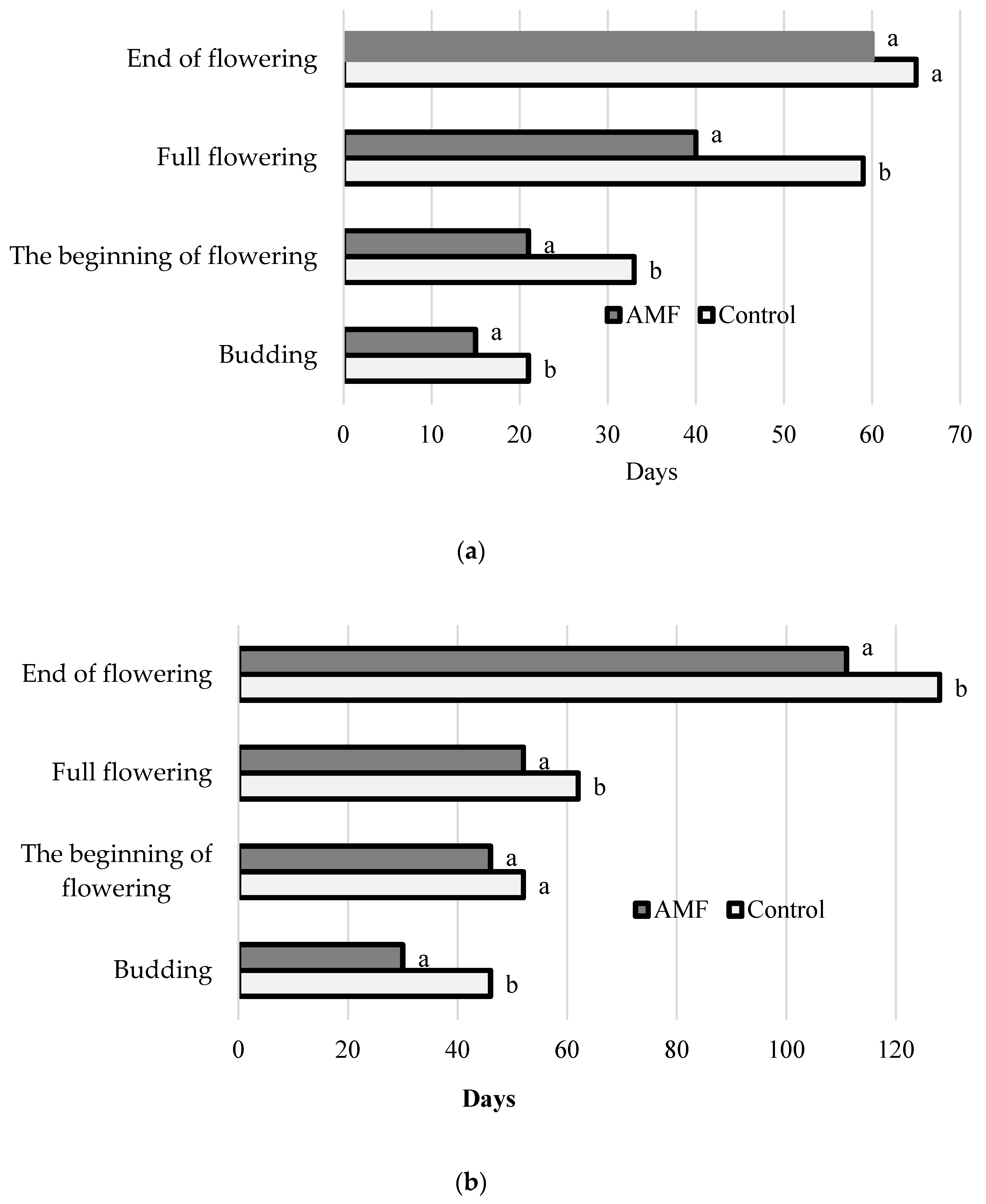
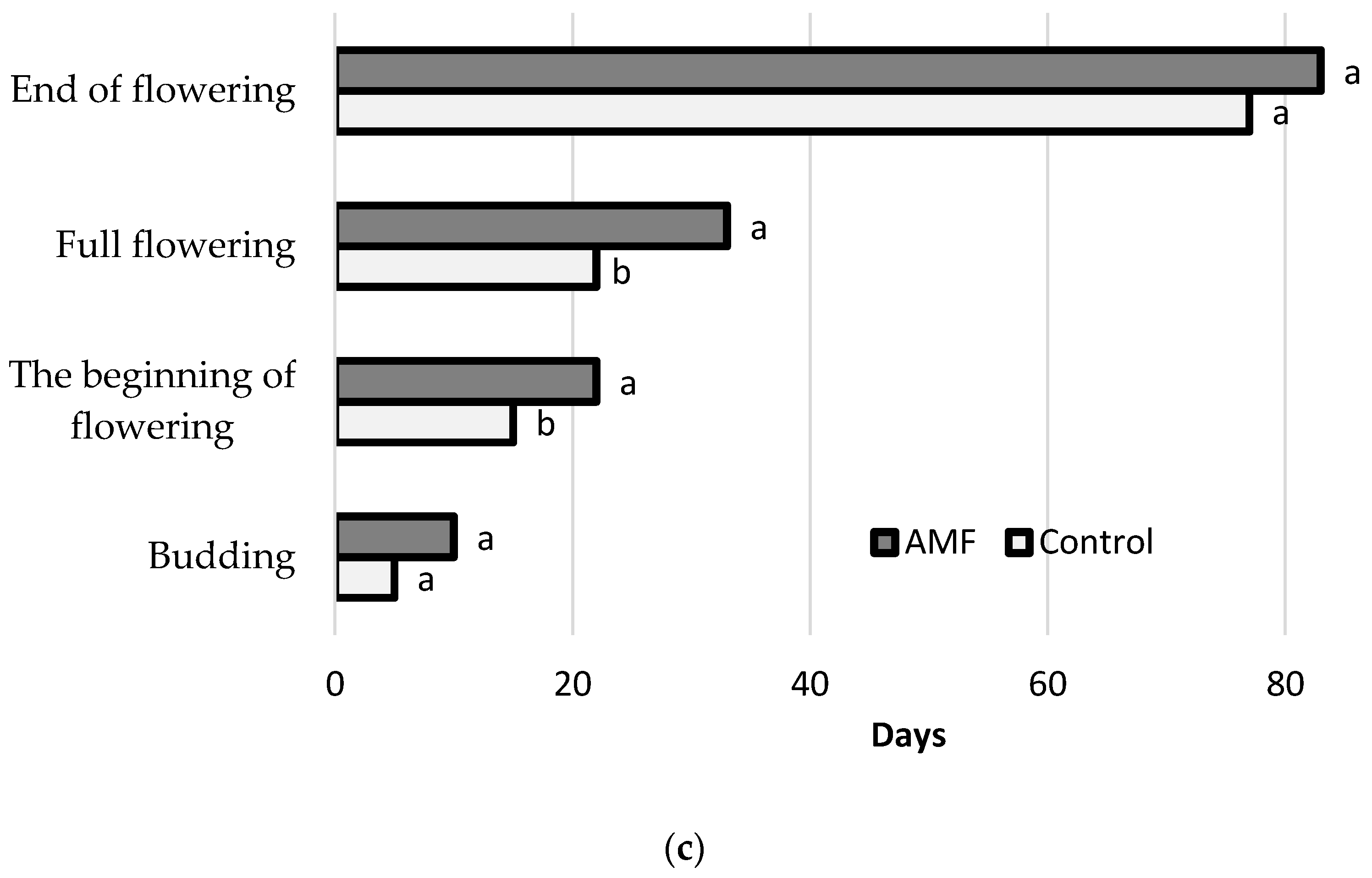
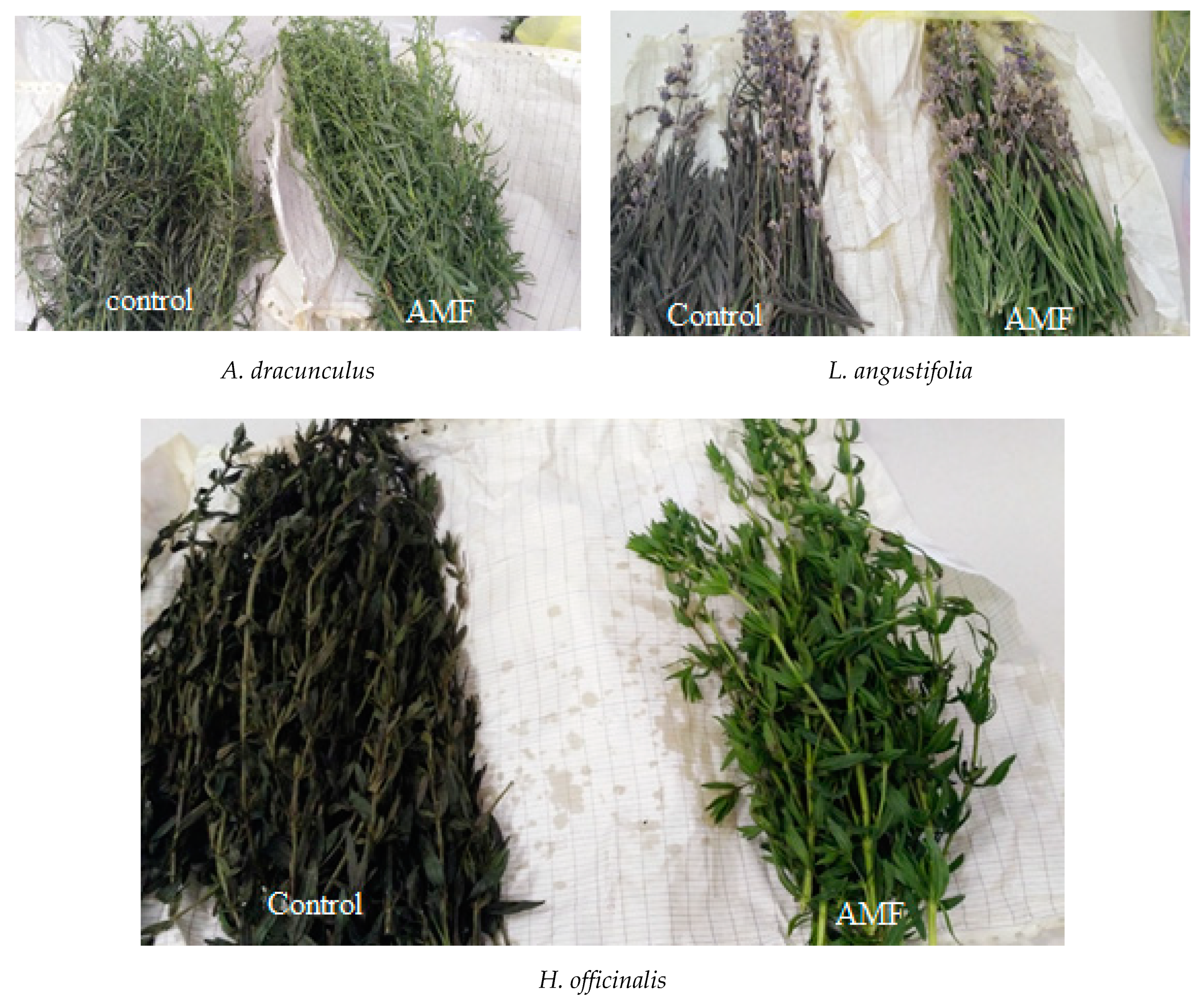

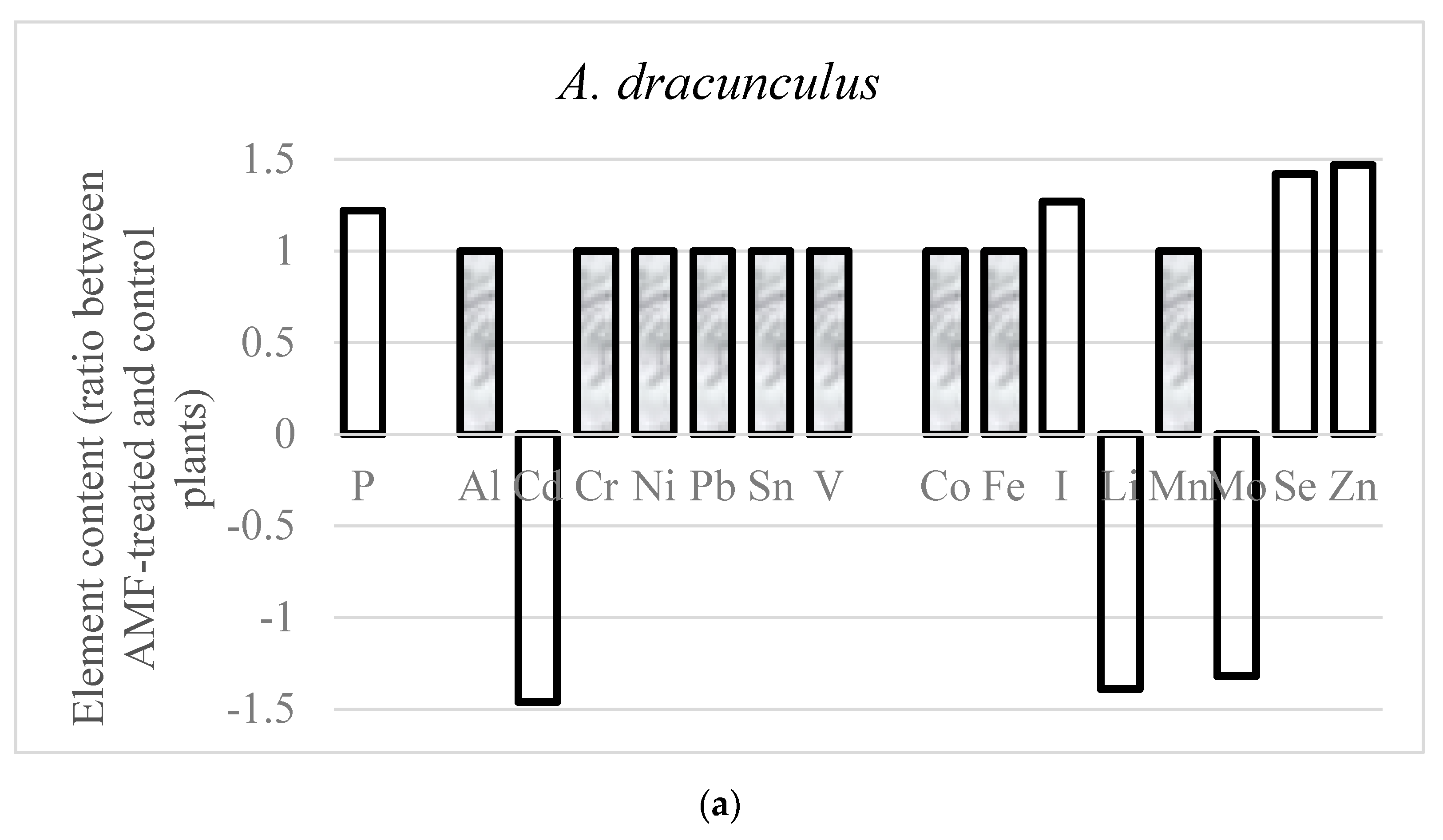
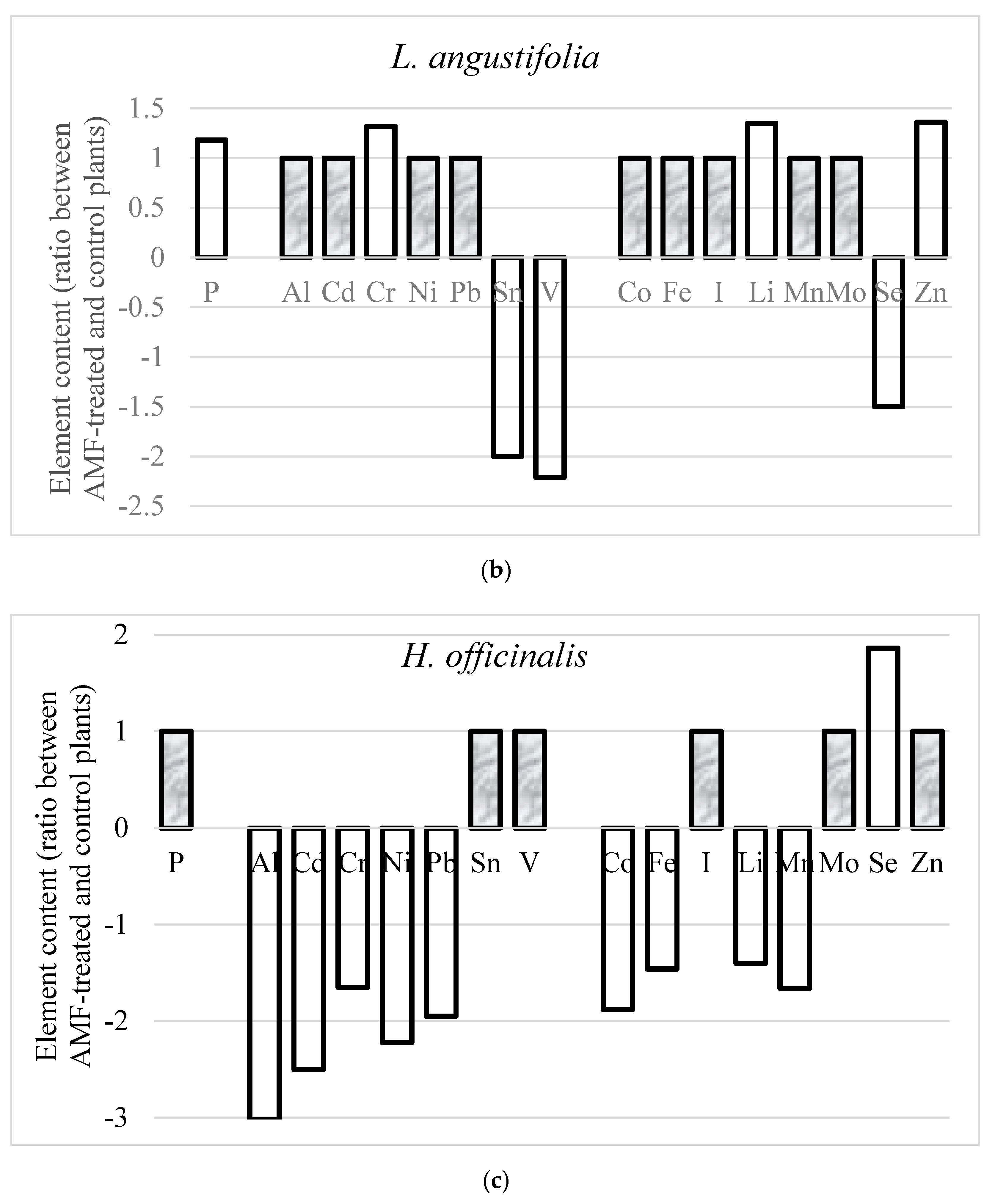
| Parameter | A. dracunculus | L. angustifolia | H. officinalis | |||
|---|---|---|---|---|---|---|
| Control | AMF | Control | AMF | Control | AMF | |
| Root mycorrhizal colonization (%) | 23.8 ± 1.9 c | 61.5 ± 3.7 a | 24.6 ± 2.8 c | 52.3 ± 4.1 b | 23.3 ± 2.0 c | 62.7 ± 4.0 a |
| Plant height (cm) | 52 ± 2 a | 54 ± 2 a | 65.5 ± 3.5 a | 66 ± 2a | 72.5 ± 2.5 b | 67.5 ± 2.5 a |
| Plant biomass (g) | 285 ± 22 b | 340 ± 30 a | 390 ± 34 a | 360 ± 31 a | 295 ± 25 b | 400 ± 36 a |
| Yield (kg m−²) | 0.86 ± 0.05 b | 1.02 ± 0.07 a | 0.78 ± 0.04 a | 0.72 ± 0.04 a | 0.89 ± 0.05 b | 1.20 ± 0.08 a |
| Essential oil content (% fw) | 0.68 ± 0.03 a | 0.70 ± 0.03 a | 1.10 ± 0.70 b | 1.30 ± 0.80 a | 0.4 ± 0.01 a | 0.4 ± 0.01 a |
| Essential oil yield (g m−²) | 5.8 ± 0.2 b | 7.1 ± 0.3 a | 8.6 ± 0.4 a | 9.4 ± 0.5 a | 3.6 ± 0.1 b | 4.8 ± 0.2 a |
| Dry matter (%) | 28.4 ± 1.0 a | 29.3 ± 0.3 a | 24.6 ± 0.8 a | 26.5 ± 1.0 a | 26.4 ± 0.7 a | 26.8 ± 0.8 a |
| TDS (mg g−1 dw) | 58.1 ± 1.4 a | 59.8 ± 1.2 a | 43.4 ± 1.0 a | 45.3 ± 1.0 a | 56.7 ± 1.1 a | 58.0 ± 1.2 a |
| Species | Treatment | Essential Oil Component % | AOA mg GAE g−1 | Phenolics mg GAE g−1 | |
|---|---|---|---|---|---|
| A. dracunculus | Control | Methyl charvicol | 79.3 | 58.3 | 18.5 |
| AMF | 81.1 | 58.8 | 18.6 | ||
| ns | ns | ns | |||
| L. angustifolia | Control | Linalool | 34.6 a | 67.9 | 19.8 |
| Linalyl aetate | 18.8 b | ||||
| AMF | Linalool | 36.5 a | 74.1 | 19.3 | |
| Linalyl acetate | 25.2 a | ||||
| ns | ns | ||||
| H. officinalis | Control | Isopinocamphone | 25.1 | 57.0a | 16.3 |
| Pinocamphone | 10.7 | ||||
| AMF | Isopinocamphone | 27.2 | 51.6b | 15.0 | |
| Pinocamphone | 11.9 | ||||
| ns | ns | ||||
| A. dracunculus | L. angustifolia | H. officinalis | ||||
|---|---|---|---|---|---|---|
| Control | AMF | control | AMF | control | AMF | |
| Ascorbic acid (mg 100 g−1) | 31.0 ± 0.8 a | 51.3 ± 1.4 a | 13.4 ± 1.6 a | 48.9 ± 1.1 b | 14.1 ± 1.0 a | 46.8 ± 1.2 b |
| Chlorophyll a (mg g−1) | 1.23 ± 0.1 b | 3.78 ± 0.2 a | 0.83 ± 0.1 b | 1.16 ± 0.1 a | 1.46 ± 0.1 b | 1.77 ± 0.1 a |
| Chlorophyll b (mg g−1) | 0.74 ± 0.04 a | 0.81 ± 0.05 a | 0.55 ± 0.02 b | 0.64 ± 0.02 a | 0.80 ± 0.05 b | 1.04 ± 0.08 a |
| Carotenes (mg g−1) | 0.21 ± 0.01 b | 0.28 ± 0.01 a | 0.14 ± 0.01 b | 0.23 ± 0.01 a | 0.30 ± 0.01 b | 0.33 ± 0.01 a |
| Phenolics (mg GAE g−1 dw) | 12.8 ± 0.5 b | 19.3 ± 0.8 a | 11.2 ± 0.5 b | 15.9 ± 0.7 a | 15.0 ± 0.7 a | 15.0 ± 0.7 a |
| AOA (mg g−1) | 53.0 ± 2.0 b | 71.8 ± 2.4 a | 38.6 ± 1.3 b | 73.3 ± 2.5 a | 31.5 ± 1.0 b | 61.2 ± 2.1 a |
| Species | Treatment | Ca | K | Mg | Na | P |
|---|---|---|---|---|---|---|
| A. dracunculus | Control | 21.7 a | 29.1 a | 4.13 a | 1.11 a | 4.47 a |
| AMF | 20.2 a | 33.1 a | 3.11 a | 1.19 a | 5.43 b | |
| L. angustifolia | Control | 12.9 a | 31.8 a | 5.45 a | 0.82 a | 3.62 a |
| AMF | 15.6 a | 29.7 a | 5.55 a | 1.03 a | 4.26 b | |
| H. officinalis | Control | 27.9 a | 20.2 a | 4.55 a | 0.75 a | 3.71 a |
| AMF | 27.9 a | 19.8 a | 4.19 a | 0.78 a | 3.74 a |
| Element | A. dracunculus | L. angustifolia | H. officinalis | |||
|---|---|---|---|---|---|---|
| Control | AMF | Control | AMF | Control | AMF | |
| B | 39.6 a | 43.5 a | 14.5 a | 15.3 a | 16.5 a | 16.6 a |
| Co | 0.07 a | 0.07 a | 0.26 a | 0.22 a | 0.15 a | 0.08 b |
| Cu | 13.2 a | 13.4 a | 9.2 a | 10.2 a | 12.0 a | 9.8 a |
| Fe | 79.2 a | 77.3 a | 182.0 a | 215.0 a | 155.0 a | 106.0 b |
| I | 1.13 a | 1.44 b | 1.04 a | 1.23 a | 0.9 a | 0.92 a |
| Li | 0.99 a | 0.71 b | 0.31 a | 0.42 b | 0.21 a | 0.15 b |
| Mn | 69.2 a | 72.6 a | 65.3 a | 52.4 b | 45.3 a | 27.3 b |
| Mo | 0.90 a | 0.68 b | 1.24 a | 1.36 a | 1.29 a | 1.16 a |
| Se | 0.12 a | 0.17 b | 0.15 a | 0.10 b | 0.07 a | 0.13 b |
| Si | 3.36 a | 3.67 a | 3.22 a | 3.71 a | 3.36 a | 3.03 a |
| Zn | 21.6 a | 31.7 b | 16.0 a | 21.7 b | 20.4 a | 19.7 a |
| Element | A. dracunculus | L. angustifolia | H. officinalis | |||
|---|---|---|---|---|---|---|
| Control | AMF | Control | AMF | Control | AMF | |
| Al | 33.5 a | 36.7 a | 107.0 a | 132.0 a | 89.6 a | 29.7 b |
| As | 0.13 a | 0.15 a | 0.26 a | 0.26 a | 0.17 a | 0.17 a |
| Cd | 0.35 a | 0.24 b | 0.05 a | 0.04 a | 0.15 a | 0.06 b |
| Cr | 0.29 a | 0.24 a | 0.59 a | 0.78 b | 0.56 a | 0.34 b |
| Ni | 2.70 a | 2.31 a | 2.50 a | 3.00 a | 3.13 a | 1.41 b |
| Pb | 0.16 a | 0.15 a | 0.54 a | 0.47 a | 0.37 a | 0.19 b |
| Sn | 0.03 a | 0.04 a | 0.04 a | 0.02 b | 0.04 a | 0.03 a |
| Sr | 65.9 a | 80.1 a | 137.0 a | 163.0 a | 72.1 a | 76.0 a |
| V | 0.44 a | 0.43 a | 0.31 a | 0.14 b | 0.15 a | 0.16 a |
| March | April | May | June | July | August | September | |
|---|---|---|---|---|---|---|---|
| Average daily temperature (°С) | 6.9 | 11.2 | 17.2 | 24.8 | 23.2 | 24.9 | 19.9 |
| Minimum temperature (°С) | −1.4 | 3 | 7.7 | 15.9 | 15 | 16.6 | 9.2 |
| Maximum temperature (°С) | 17.3 | 22.2 | 28 | 34.7 | 32.7 | 36.8 | 30.6 |
| Sunshine duration (hours) | 220 | 237 | 258 | 312 | 316 | 317 | 250 |
| Rainfall (mm) | 24.3 | 43.7 | 0.9 | 72.5 | 21.3 | 22.3 | 15.2 |
| Air humidity (%) | 64 | 63 | 69 | 58 | 59 | 54 | 58 |
© 2020 by the authors. Licensee MDPI, Basel, Switzerland. This article is an open access article distributed under the terms and conditions of the Creative Commons Attribution (CC BY) license (http://creativecommons.org/licenses/by/4.0/).
Share and Cite
Golubkina, N.; Logvinenko, L.; Novitsky, M.; Zamana, S.; Sokolov, S.; Molchanova, A.; Shevchuk, O.; Sekara, A.; Tallarita, A.; Caruso, G. Yield, Essential Oil and Quality Performances of Artemisia dracunculus, Hyssopus officinalis and Lavandula angustifolia as Affected by Arbuscular Mycorrhizal Fungi under Organic Management. Plants 2020, 9, 375. https://doi.org/10.3390/plants9030375
Golubkina N, Logvinenko L, Novitsky M, Zamana S, Sokolov S, Molchanova A, Shevchuk O, Sekara A, Tallarita A, Caruso G. Yield, Essential Oil and Quality Performances of Artemisia dracunculus, Hyssopus officinalis and Lavandula angustifolia as Affected by Arbuscular Mycorrhizal Fungi under Organic Management. Plants. 2020; 9(3):375. https://doi.org/10.3390/plants9030375
Chicago/Turabian StyleGolubkina, Nadezhda, Lidia Logvinenko, Maxim Novitsky, Svetlana Zamana, Sergey Sokolov, Anna Molchanova, Oksana Shevchuk, Agneszka Sekara, Alessio Tallarita, and Gianluca Caruso. 2020. "Yield, Essential Oil and Quality Performances of Artemisia dracunculus, Hyssopus officinalis and Lavandula angustifolia as Affected by Arbuscular Mycorrhizal Fungi under Organic Management" Plants 9, no. 3: 375. https://doi.org/10.3390/plants9030375
APA StyleGolubkina, N., Logvinenko, L., Novitsky, M., Zamana, S., Sokolov, S., Molchanova, A., Shevchuk, O., Sekara, A., Tallarita, A., & Caruso, G. (2020). Yield, Essential Oil and Quality Performances of Artemisia dracunculus, Hyssopus officinalis and Lavandula angustifolia as Affected by Arbuscular Mycorrhizal Fungi under Organic Management. Plants, 9(3), 375. https://doi.org/10.3390/plants9030375








